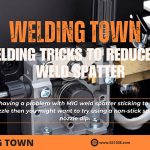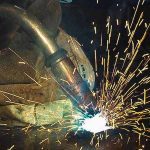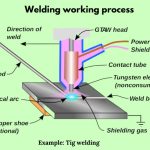Stick welding, commonly referred to as shielded metal arc welding (SMAW), is a manual method that uses a flux-coated consumable electrode with a metal rod as its core. The necessary heat is produced by an arc formed either by direct current or alternating current between the welding electrodes and the base metal. It is the most common approach in the US.
Learn here about Shielded Metal Arc Welding (SMAW).
021208.com
A layer of shielding slag is produced when the flux coating disintegrates and releases vapors that serve as a shielding gas. Both shield the weld region from contamination by the atmosphere. The molten pool that forms as the metal rod inside the electrode melts into a weld produces the joint.
The width and height of the weld beads, the depth of the weld, and the amount of spatter are all factors that the welder may regulate. Comparing stick welding to other techniques like TIG welding, it is less expensive. It is portable, functional in any position, and compatible with any thickness. The slag produced during the welding processes and slow speeds is the main drawbacks (unless you are highly skilled).
ARC WELDING WITH A SMAW
Stick welding gets its name from the electrode’s design, which resembles a stick. It can be used to weld a variety of metals, including cast iron, steel, and stainless steel.
Stick welding machines use either direct current (DC) or alternating current to deliver continuous current (CC) or (AC). Depending on the polarity, direct current flows in a variety of directions. The flow of current alternates between directions. Amperes are used to measure the amount of power in the electrical circuit that powers the weld. For welding larger metals or electrodes, more current or amperage is required.
Iron and steel are often joined using SMAW arc welding. It is usable in every position:
- Flat
- Vertical
- Horizontal
- Overhead
SHIELDED METAL ARC WELDING: PROCESS
The base metal and tip of a consumable electrode are melted during Process SMAW Arc Welding (stick welding), which uses arc heat. A welding circuit or electric circuit includes the electrode and the base metal. This circuit consists of:
- power supply
- welding cables
- Holder for an electrode
- Ground clamp
- the work or base metal
- Arc welding electrode
The work is connected to one cable, and the electrode holder is connected to the other. When an arc is created between the electrode’s tip and the base metal, welding is initiated. Due to the heat, the tip and the surface of the work melt. Tiny globules of molten metal condense on the electrode tip and move into the molten pool via the arc. As the electrode is used up, fillers are placed.
Metal transmission is facilitated for welds made in a flat or horizontal position by:
- GRAVITY – Because of gravity, out-of-place welding does not allow the much-molten metal to be absorbed by the base metal. It is recommended to use smaller electrodes, lower amperages, and shorter arcs.
- EXPANSION OF GAS – Due to the heat of the boiling electrode tip, gases are created when the electrode coating melts and expands. The coating, which determines the direction of gas expansion, extends just slightly above the electrode’s metal tip. This facilitates the flow of molten metal into the pool used for welding.
- POWER SOURCES – The molten globule spray at the tip is an electric conductor, therefore magnetic forces operating at an angle of 90 degrees (usually sideways) to the direction of the current flow change the globule spray.
This is beneficial for welding in overhead, vertical, and horizontal positions. Arc blast is more likely to occur in rods with higher tensile strength. These forces can be significantly impacted by the location of the ground cable.
- SURFACE FORCE – Surface tension is the force maintaining the filler metal and slag in contact with the molten base metal in the crater.
It establishes the contour of the weld and aids in holding the molten metal in place during flat, horizontal, vertical and overhead welding.
Shielded metal arc welding is a manual method that uses a flux-coated consumable electrode with a metal rod as its core.
021208.com
SHIELDED METAL ARC WELDING: VARIABLES
When welding, the following parameters can be adjusted to regulate the weld’s properties (size of bead and penetration):
- Size and electrode type
- Amperage (changed on the stick welding machine) (changed on the stick welding machine)
- The rate at which you move the electrode along the welding joint (called the speed of travel)
- arc’s width (distance between the metal and the tip of the electrode). Use an arc length that is equal to the diameter of the core wire inside the electrode as a general guideline.
- Angle of the electrode
- The most penetration is made possible by being perpendicular (90 degrees).
- Less penetration at 45 degrees
- Control of weld width by side-to-side electrode motion
- When employing DC or direct current, polarity control (the direction in the electrical current flows)
ADVANTAGES AND DISADVANTAGES OF SHIELDED METAL ARC WELDING (SMAW)
Stick welding, or SMAW, needs only some essential welding tools and works well for field operations because it is so portable.
ADVANTAGES OF SMAW
- 30% to 50% less expensive than conventional welding techniques
- lightweight machinery
- Electrodes come in a variety of varieties.
- good in confined spaces
- Cleaning the metal surface before welding is less demanding than with other techniques like TIG
DISADVANTAGES OF SMAW
- After welding, slag needs to be removed. Slag inclusions created by slag entrapment in SMAW processes need to be eliminated.
- Need to stop welding when you reach the final 2 inches of the electrode due to unused electrode stubs.
- Spatter
- Slow SMAW relative speed.
- Labor-intensive slag removal and cleanup
- Produces more heat and sparks than conventional welding techniques.
- The dust produced by chipping and grinding finished welds is hazardous.
- During welding, a break is necessary to swap out the electrode and remove the slag.
- About 44% of consumed electrodes are scattered or left-over electrode stubs.










